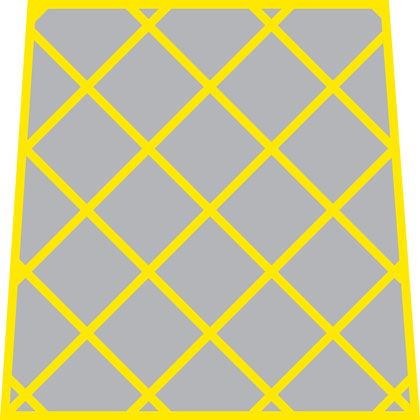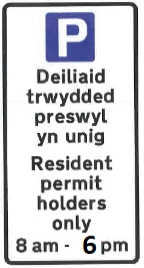Bus lanes
Bus services are particularly susceptible to the effects of traffic congestion. Any delays can increase operating costs and lead to higher fares.
Bus lanes and bus gates can:
- quicken journey times
- increase reliability
- encourage the use of sustainable transport.
We will issue you with a Penalty Charge Notice (PCN) if you fail to comply with bus lane restrictions.
The Highway Code (141) states:
'Bus lanes. These are shown by road markings and signs that indicate which (if any) other vehicles are permitted to use the bus lane. Unless otherwise indicated, you should not drive in a bus lane during its period of operation'.
In Carmarthenshire, all bus lanes operate 24 hours a day, every day.
Vehicles that can use bus lanes in Carmarthenshire:
- Buses
- Licenced Hackney carriages
- Licenced vehicles for private hire
- Motorcycles (without side cars)
- Pedal cycles
- Emergency service vehicles
Recognising a bus lane
Please make sure you are familiar with all signage relating to bus lanes:

Bus lanes are also bounded by a solid white line. You should not cross the line unless permitted. Please be patient. If traffic is busy in the unrestricted lanes, this does not mean you can use bus lanes or bus gates illegally. Many people believe that there is a 20 metre grace distance for an unauthorised vehicle to use a bus lane. This ’20 metre rule’ has no basis in law.
School Streets
A 'School Streets' scheme implements a temporary restriction on the local road network directly outside of a school site in order to limit motor vehicle access. The restriction on motor vehicle access applies at school drop-off and pick-up times for both school traffic and through traffic.
Currently there are two School Streets schemes operating in the county, with a further scheme currently undergoing feasibility work. The two schemes currently operating in Carmarthenshire are at:
- Maes Y Morfa Primary School (Olive Street & Bowen Terrace Llanelli)
- Burry Port Primary School (Elkington Park, Burry Port)
Recognising School streets
School streets are indicated with a sign similar to the one shown here:

School Road restrictions are only enforced during the periods noted on the sign.
It is recognised that not all motor traffic can be restricted during the School Streets closure, and therefore certain exclusions are granted using permits. Prior authorisation is required to all vehicles needing access to the school premises during the prohibition times.
Typically, school staff are granted access to the closed roads in order to access the school site. Residents of the roads that are included in the School Streets closure are also granted access. This is typically done through the use of permits for both school staff and residents.
Vehicle owners are able to apply for a digital permit by completing an application form.
Any vehicle that enters the zone during the scheme’s operating hours that has not been granted an exemption (and has secured a current digital permit) will be automatically issued a penalty charge notice (PCN).
For more information or to apply for exemption please visit: School Streets
Box junctions
Yellow box junctions are placed at busy junctions to aid the flow of traffic through the junction. They can also be placed to keep a road space free to ensure emergency services have a clear exit from fire stations and hospitals.
Recognising a box junction
Yellow box junctions are indicated by yellow crisscross lines painted on the carriageway:

They can be found at road junctions and at some roundabouts and there are no requirements for yellow box junctions to be accompanied by signs or a Traffic Regulation Order.
Using a box junction
The rules of box junctions can be found in the Highway Code (174)
You may enter a yellow box junction when your exit is clear and there is enough space on the other side of the junction for your vehicle to clear the box completely without stopping. You can stop in a yellow box junction when turning right if you are prevented from turning by oncoming traffic, or by other vehicles waiting to turn right.
We issue PCNs for a failure to comply with the rules of box junctions.
- Check your exit is clear. If you simply follow the vehicle in front of you without doing so it may stop and prevent you from fully crossing the junction.
- Just because a traffic light is green this does not mean the rules of box junctions do not apply.
- Don't let other drivers pressure you into entering the box when a clear exit is not available
Banned Turns
Certain manoeuvres (turns) are banned on some of our roads. Ignoring these bans can be very dangerous and could result in an accident.
A banned turn occurs when drivers ignore signs giving instructions as to a direction they must or must not take. Enforcement of banned turns helps to manage how traffic uses the road and makes it safer for pedestrians and other drivers.
Recognising a banned turn sign
These signs are listed in the Highway Code, which you may wish to consult. They are either signs with:
- A white arrow on a blue background showing you the direction you must take, or
- A red outer circle with a red line showing you the direction you must not take
| What you MUST do |
Traffic Sign |
| Straight ahead only: You must continue ahead only. You must not turn left, right or make a U turn. |
 |
| Left turn only: You must turn left at the junction ahead. You must not turn right, go straight ahead or make a U turn. |
 |
| Right turn only: You must turn right at the junction ahead. You must not turn left, go straight ahead or make a U turn. |
 |
| Turn left: You must turn left. You must not turn right, go straight ahead or make a U turn. |
 |
| Right turn: You must turn right. You must not turn left, go straight ahead or make a U turn. |
 |



























